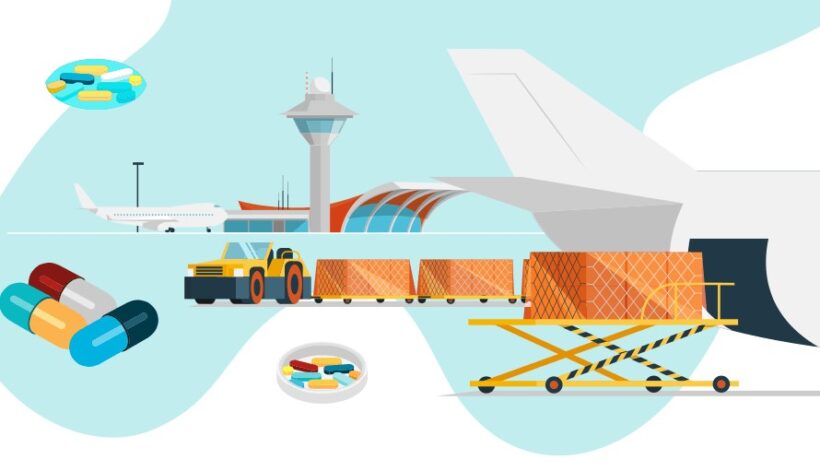Transporting pharmaceuticals safely is crucial to ensure the integrity and effectiveness of medications, as well as to comply with regulatory requirements. Whether you’re a pharmaceutical manufacturer, distributor, or transporter, following strict guidelines for secure delivery is essential to prevent contamination, tampering, or theft. In this blog post, we’ll explore some valuable safety tips for transporting pharmaceuticals, helping you mitigate risks and maintain the quality of these critical products.
Packaging and Labeling

When it comes to transporting pharmaceuticals, proper packaging and labeling are paramount. The packaging should be sturdy and tamper-evident, providing adequate protection against physical damage, temperature fluctuations, and unauthorized access. Use quality materials that meet industry standards and consider additional measures such as shock-absorbing materials or temperature-controlled packaging for sensitive medications. Additionally, ensure that each package is properly labeled with essential information including the name of the medication, dosage, expiration date, lot number, and handling instructions. Clear and accurate labeling not only facilitates efficient handling but also helps in tracking and tracing products throughout the supply chain.
Temperature Control

Maintaining the appropriate temperature during transportation is critical for preserving the efficacy and stability of pharmaceutical products, especially those that are temperature-sensitive. Implementing temperature-controlled solutions such as insulated containers, refrigerated trucks, or cold chain logistics can help prevent exposure to extreme temperatures that could compromise the integrity of medications. It’s essential to monitor temperatures continuously throughout the transportation process and have contingency plans in place to address any deviations from the required temperature range. Collaborate with reputable logistics partners who have experience in handling temperature-sensitive goods and ensure that all personnel involved are properly trained in temperature management protocols.
Security Measures
Protecting pharmaceutical shipments from theft and unauthorized access is a top priority for ensuring product safety and regulatory compliance. Implement robust security measures at every stage of the transportation process, including secure storage facilities, tamper-evident seals, GPS tracking systems, and security escorts for high-value shipments. Conduct thorough background checks on personnel involved in handling and transporting pharmaceuticals, and establish strict access control procedures to prevent unauthorized individuals from tampering with or stealing medications. Additionally, consider using covert security measures such as RFID tags or serialization to track and authenticate products, further enhancing security and traceability.
Compliance and Documentation
Adhering to regulatory requirements and maintaining accurate documentation is essential for the safe and legal transportation of pharmaceuticals. Familiarize yourself with relevant regulations and guidelines issued by authorities such as the Food and Drug Administration (FDA) or the World Health Organization (WHO), and ensure full compliance with applicable laws and standards. Keep detailed records of each shipment, including product information, transportation conditions, handling procedures, and any incidents or deviations encountered during transit. Proper documentation not only demonstrates regulatory compliance but also provides a valuable record for quality assurance, risk management, and liability purposes.
Ensuring the competence and awareness of personnel involved in pharmaceutical transportation is crucial for minimizing risks and ensuring safe delivery. Provide comprehensive training programs covering topics such as proper handling procedures, security protocols, temperature management, and regulatory compliance. Emphasize the importance of adherence to standard operating procedures (SOPs) and encourage a culture of accountability and vigilance among employees. Regularly assess and update training materials to reflect changes in regulations or best practices, and conduct ongoing evaluations to measure the effectiveness of training efforts. Investing in the education and development of your workforce not only enhances safety and compliance but also contributes to overall operational excellence. For further insights into enhancing your pharmaceutical transportation processes, visit www.divinetrans.com.
Identifying and mitigating potential risks associated with pharmaceutical transportation is essential for safeguarding product quality and patient safety. Conduct thorough risk assessments to identify vulnerabilities in your transportation processes, including environmental hazards, security threats, logistical challenges, and regulatory compliance issues. Develop comprehensive risk management strategies that address identified risks and prioritize proactive measures to prevent incidents before they occur. Continuously monitor and evaluate your risk management efforts, and be prepared to adapt and refine your strategies in response to changing circumstances or emerging threats. By taking a proactive approach to risk management, you can minimize disruptions, protect your reputation, and ensure the safe and secure transportation of pharmaceuticals.
Inventory Management
Effective inventory management is essential for optimizing pharmaceutical transportation processes and ensuring the timely delivery of medications. Utilize advanced inventory tracking systems to accurately monitor stock levels, expiration dates, and product movement throughout the supply chain. Implement automated replenishment systems to prevent stockouts and minimize the risk of product shortages. Conduct regular audits to reconcile physical inventory with digital records and identify any discrepancies or potential issues. By maintaining tight control over inventory, you can streamline operations, reduce costs, and improve overall efficiency in pharmaceutical transportation.
Route Optimization
Optimizing transportation routes can significantly enhance the efficiency and cost-effectiveness of pharmaceutical delivery operations. Utilize route planning software and geographical data to identify the most efficient routes based on factors such as distance, traffic patterns, and delivery schedules. Consider implementing dynamic routing algorithms that can adjust routes in real time to account for unexpected delays or changes in demand. Collaborate with logistics partners to explore opportunities for consolidation and route optimization, minimizing the number of trips and reducing carbon emissions. By optimizing transportation routes, you can improve delivery times, reduce fuel consumption, and enhance overall sustainability in pharmaceutical transportation.
Quality Assurance
Maintaining strict quality assurance protocols is paramount for ensuring the safety, efficacy, and regulatory compliance of pharmaceutical products during transportation. Establish robust quality control measures to verify the integrity of shipments, including visual inspections, temperature monitoring, and product testing. Implement quality management systems that adhere to international standards such as ISO 9001 or Good Distribution Practice (GDP), ensuring consistent quality across the entire supply chain. Conduct regular audits and inspections of transportation facilities, vehicles, and equipment to identify and address any potential quality issues or non-conformities. By prioritizing quality assurance, you can instill confidence in stakeholders and uphold the highest standards of product quality and safety.
Conclusion
In conclusion, transporting pharmaceuticals safely requires careful planning, rigorous adherence to guidelines, and continuous vigilance throughout the supply chain. By implementing the safety tips outlined in this blog post, you can minimize risks, maintain product integrity, and ensure the reliable delivery of medications to patients in need. Remember to stay informed about industry best practices and regulatory requirements, and collaborate with trusted partners who share your commitment to safety and quality. Together, we can uphold the highest standards of pharmaceutical transportation and contribute to better healthcare outcomes for all.


